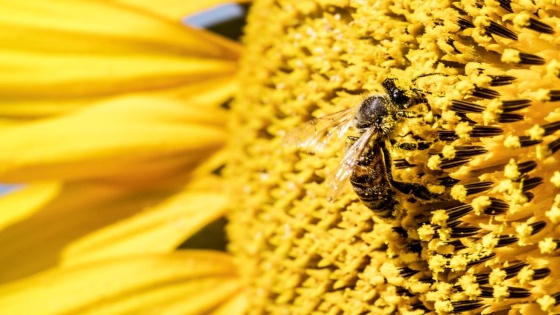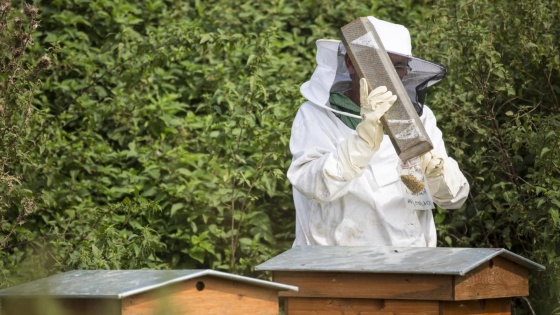Pollinators and Agriculture working together
The unexplained rise in honeybee deaths has become an issue of great concern. As honeybees are one of the most important pollinators for wild plants and crops, they are closely linked to both agriculture and biodiversity.
Many plants including food crop plants depend on insects to move pollen between their flowers, that allows them to produce seed and fruits. The group of insects that perform this function is diverse and although flowers seem to be visited by a great diversity of insects, the majority of pollinators are derived from only four insect orders: the bees and wasps (Hymenoptera), the flies (Diptera), the butterflies and moths (Lepidoptera), and the beetles (Coleoptera). Bees are easily the most important of these in terms of pollination and includes bumblebees, solitary bees and honeybees.

Many have specific pollination functions to deliver so it is becoming more important than ever that there are enough of them present in the landscape to ensure a diverse food supply and to support other biodiversity. For example, wild bees and honeybees play an important role in the UK with some 85% of the apple crop and 45% of the strawberry crop relying on them for pollination services.
Their importance within our eco system
Without the help of the bees, yields of these two high value crops would significantly decrease. It has been estimated that insect pollination contributes £630 million per year to the UK economy, and around £150 billion per year globally.
Over the last decade, bees have been the focus of much research and monitoring because of their importance for pollination worldwide and our increasing awareness of their decline. There are basic differences in biology between honeybees, bumblebees and solitary bees, so understanding the key stages of their life cycles in terms of mating, nesting habitat and food resources (flowers) is critical for supporting their populations in farmland.
Want to read more?
“Habitat Creation and Management for Pollinators”
“Habitat Creation and Management for Pollinators” by Marek Nowakowski and Richard Pywell is the distillation of a 20-year research partnership between Marek Nowakowski (a practitioner with a passion for wildlife conservation on farmland) and applied ecologists working for the Centre for Ecology & Hydrology. It has a great description of the detailed differences between the various bee species, copied here for ease of reference.
Bumblebees
Bumblebees become active when the weather warms up in about mid-March. At this time, new queens emerge from hibernation and begin new colonies by producing female workers, each also with about a six-week life span. Males are produced in late summer, and these mate with new queens which then go into hibernation. The old queen, all workers and males die in the autumn. The new queen overwinters and emerges the following spring to begin the cycle again.
Solitary bees
As their name implies, solitary bees generally have a simpler breeding system. There is no need for a queen, as the individual females do all that is necessary to secure the next generation. Males and females hatch at the same time; the males mate immediately with the females and die shortly afterwards.

Honeybees
Honeybees are distinguished from other bees in that they are the only truly domesticated bee that produces honey, a valuable food source. The honeybee life cycle begins with a queen establishing a colonial nest or colony. After only one mating flight a queen can store enough sperm cells to enable her to lay eggs throughout her entire life. The queen dominates the hive and is essentially an ‘egg-laying machine’, producing female bees, or ‘workers’, from fertilised eggs. These worker bees live for around six weeks before they die and are replaced by new workers. Later in the season she lays unfertilised eggs that hatch into males. These go on to fertilise specially fed females that become new queens. These new queens take over the colony and the old queen leaves to set up a new one. Honeybees are the only bees to overwinter as a colony, so producing an unbroken chain of occupancy.
Many of the habitats and management techniques specifically tailored for bees are equally beneficial to the other insect pollinators, which effectively doubles the value of sown habitats. Knowing which of the widespread plant species provide food resources for bees can help us design and sow the best seed mixtures as pollinator habitat.
Bees must visit flowering plants to gather two vitally important food resources, sugar-rich nectar (used to provide energy for flying) and protein-rich pollen (used by females to develop ovaries and feed their young). Habitats need to provide an unbroken supply of pollen and nectar from March to September, the main period of activity for pollinators.
Establishing the mixtures at the right scale and in the right places are fundamental to providing the resources needed by farmland pollinators to help their populations remain stable or increase and spread across the landscape.
Bees’ tongues can vary greatly in size and have been formed into a tube for sucking up nectar, a bit like drinking through a straw. The Garden Bumblebee (Bombus hortorum) has a tongue length (15mm) that is ¾ of its body length. This allows them to feed on flowers with a long flower tube (corolla), such as Red Clover. At the other end of the scale some of the mining bees (e.g. Andrena spp.) have a tongue length of 4 to 5mm. This enables them and flies (which have more of a pad than a tongue) to feed on open flowers, such as Daisies and Cow Parsley.
Agronomic issues like soil fertility and weed pressures are the same for sown pollinator habitats as crops sown for food as they often share similar plant species.
Did you know?
- There are at least 20,000 species of bees on earth and more than 2,500 in the EU.
- Honeybees typically die of exhaustion about three weeks after first taking flight, having flown about 800 km, sometimes carrying up to half their bodyweight, in foraging for nectar and pollen.
- There are around 700,000 beekeepers in the EU.
- The EU produces around 200,000 tons of honey each year.
- The commercial value of bees' pollination services is estimated at £200m per year in the UK and $14bn in the United States and €153bn worldwide.
Further interesting links
- north_east BEE DOC (Bees in EuropE and the Decline Of honeybee Colonies)
- north_east Project COLOSS (Prevention of COlony LOSSes)
- north_east STEP project (Status and Trends of European Pollinators)
- north_east EurBee European Association for Bee Research
- north_east German bee monitoring
- north_east USDA Bee Research Laboratory
- north_east International Commission for Plant-Bee Relationships
The Varroa mite
The Varroa mite is a major factor affecting bee health. The German bee monitoring project recently published a long-term study, which shows that Varroa is significantly related to high winter losses in honeybee colonies.
With "Mite AwayTM Quick Strips" (MAQS), BASF and NOD Apiary Products offer a solution to control the Varroa destructor. The product targets Varroa mites while they feed on developing young bees, and stops mite reproduction.
